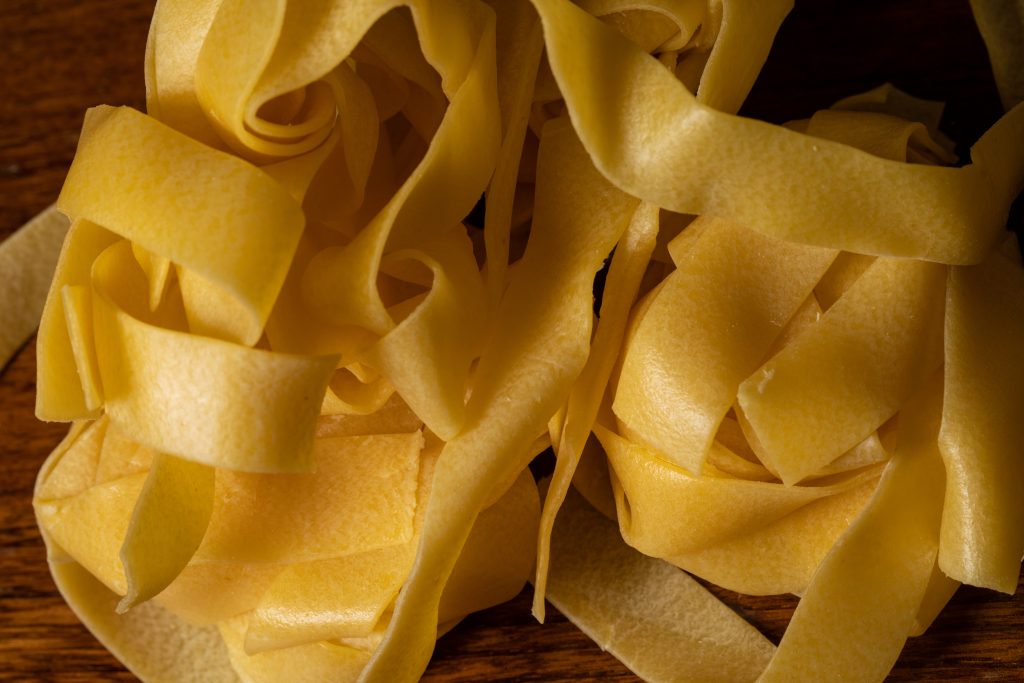13 January 2025
The history of the most popular dish in the world that’s even better and healthier in its organic version.
Fresh pasta is undoubtedly the queen of any meal. This quintessential symbol of Italian cuisine is loved all over the world and when it is made from organic flour and semolina, as promoted by the “Pure Flour From Europe” program, it is elevated to something even better and healthier: a true “star”. The international project supported by ITALMOPA (the Italian Milling Industry Association) and co-financed by the European Union, which promotes the export to Canada and the USA of Made in Europe organic soft wheat and durum wheat flours and semolina, presents the ritual and culture of organic fresh pasta, which recalls artisanal products, family memories, a special trip or meal – in one word: emotions. Pasta is certainly the staple of the Mediterranean diet, so much so that it is in demand all over the world. Pasta means Italy and especially fresh pasta, not only because it lends any sauce a unique and memorable taste, but because if made from organic flour and semolina it is also healthier.

These organic products are produced using methods which follow the natural rhythm of the land, without the use of fertilizers and chemicals. They preserve more nutrients and are so versatile. The term “fresh pasta” reflects its production method: it is the product of a series of technical operations which combine soft wheat flour or durum wheat semolina with water or eggs. The adjective “fresh” refers to the 30% moisture level of the dough.
According to the Parma Food Museums, centuries before the birth of Jesus, the Greeks and Etruscans were already producing and eating the first types of “fresh pasta”. The first indication of the existence of something similar to pasta dates back to Greek civilization in the first millennium BC. The Greek word “laganon” was used to refer to a large, flat sheet of dough cut into strips. The Latin word “laganum” derived from this, mentioned by Cicero in his writings (although it is not cooked in water) and this gave rise to the Italian word “lasagna”. Dry spaghetti-like pasta made from durum wheat, on the other hand, came from the eastern part of the Roman Empire in the first centuries after Christ, and has been documented in Sicily as early as the ninth century. In Mediterranean areas, the origins of pasta can be traced back to polenta, which was originally in the form of a “gnocco” or dumpling and then took the shape of pasta.
The first historical traces of pasta date back to the Etruscan tomb “dei Rilievi” found in Cerveteri, where utensils used to make fresh pasta are clearly identifiable. In the Middle Ages, fresh pasta stuffed with different fillings first appeared, but it had to be consumed rapidly, as they had no means of conserving it. Over time, it has become the subject of countless creative reinterpretations, from cherished family recipes to those of great chefs, everyone has at least one fresh pasta dish in their repertoire. Fresh pasta as we know it today was first made in Naples in southern Italy when “macaroni” was created for the first time. At first, pasta was considered a dish for the rich, but by the sixteenth century it was also eaten by poorer classes and the profession of pasta-maker became more common.
How do you prepare fresh pasta? The method that has traditionally been handed down is obviously made by hand: start by sifting the organic flour or semolina onto a work surface in a mound and make a well in the center. Crack the eggs in one at a time, and bring together the dough, gradually incorporating all the flour. The resulting dough must be kneaded well, then left to rest, and then kneaded again. Depending on the recipe chosen, roll out the dough and proceed to cut or shape the pasta. It is a beautiful “ritual” with different phases. The act of working the dough, firmly but with love, is a metaphor for an attitude that can also be assumed in life. Kneading is rooted in tradition, but it is also the act of creating something essential for others: fresh pasta, prepared with organic flours and semolina, is even tastier and healthier.
Basic recipe for fresh homemade pasta
Practical, quick and goes well with any sauce

Preparation: 10 minutes
Resting: 30 minutes
Ingredients for 4 people (tagliatelle)
- 2.4 cups of 00 flour
- 4 eggs
- a pinch of salt
Method
On a pastry board (preferably wooden), sift the flour and form a mound. Make a well in the center and pour in the eggs, adding a pinch of salt. Beat with a fork, incorporating the flour, and once absorbed, continue to work the dough with your hands, until you get a smooth and compact dough. Form a ball, cover with a clean cloth, and leave to rest for about 30 minutes. After the time has elapsed, take the dough and roll it out with a rolling pin on a floured pastry board. You can now create any type of pasta. For example: to prepare tagliatelle, roll out the dough until it reaches a uniform thickness of about 1/8 inch, dust well with flour and fold the dough to form a roll of pastry. With a long, sharp knife, cut the pasta into strips of the desired width.
